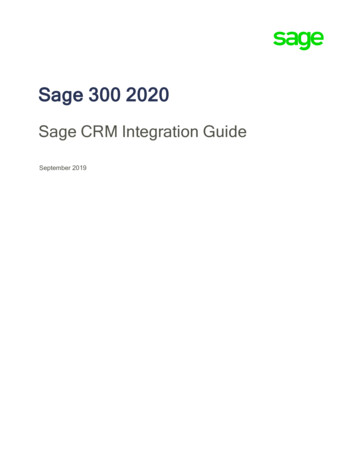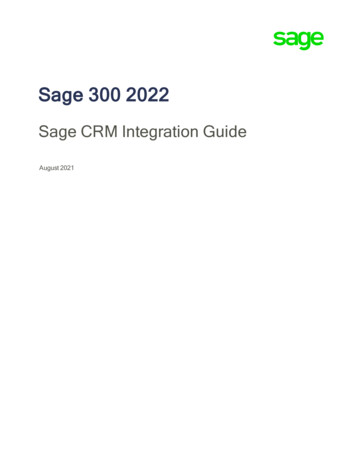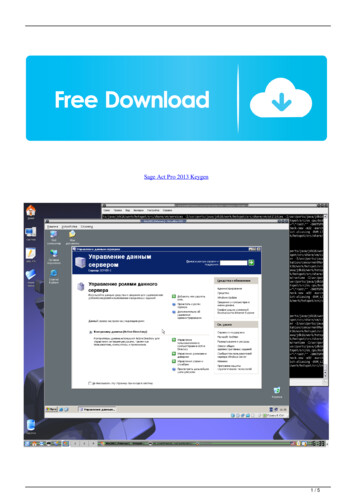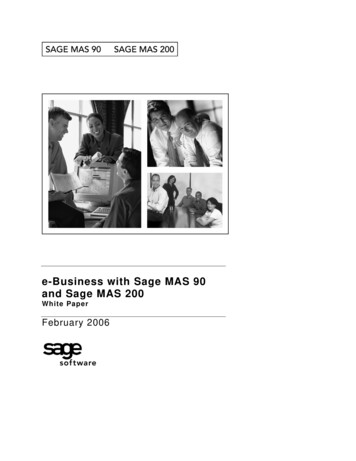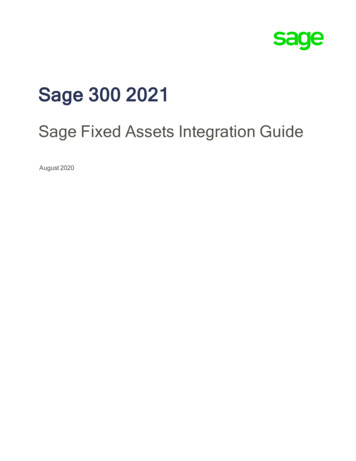
Transcription
CHAPTER 2Planning the Online SurveyAsound plan is essential to the success of any research endeavor. Surveyresearch is a process, and each element impacts the others. Researchobjectives guide questionnaire format; questionnaire format determines thetypes of questions that may be used; the types of questions used determinedata analysis; data analysis reflects research objectives; and all this is boundby time, budget, and ethical considerations.The first step in the planning process is to articulate a plan for the survey. This plan will be a handy map to which you can continually returnas you address the individual components of the survey planning process.These outlines are also particularly useful when the survey is part of a teamresearch project.In this chapter, we consider the major elements of a survey plan—namely,choosing the type of digital survey you will use, selecting survey software,writing clear project objectives, preparing timelines, and addressing ethicalconsiderations important in the online survey environment.E-Mail SurveysE-mail surveys can be economical and fast to create and deploy. When werefer to e-mail surveys, we mean surveys created using survey software andaccessed by respondents through a link in an e-mail invitation. These areamong the most common online surveys because anyone who has access toonline survey software, such as SurveyMonkey, Zoomerang, or InstantSurvey,can create an e-mail survey.According to an August 2010 report on the Pew Internet and AmericanLife Project website, 79% of Americans use e-mail daily (Smith, 2010). Thisis a substantial proportion of the overall population and renders surveys14
Chapter 2 Planning the Online Survey——15delivered by e-mail a viable option for many projects. However, percentagesof e-mail users vary by age, racial/ethnic group, income, and educationalattainment (see Table 2.1). It is, therefore, important to consult current dataregarding the demographic makeup of individuals who use Internet ande-mail to make sure this distribution method is appropriate for the population you are considering surveying.Table 2.1 Internet Use in the United States by en79Women79Race/EthnicityWhite, non-Hispanic80Black, 647865 42Household IncomeLess than 30,000/year63 30,000– 49,00084 50,000– 74,99989 75,000 95Educational AttainmentLess than high school52High school67Some college90College 96(Continued)
16——Conducting Online SurveysTable 2.1 (Continued)CharacteristicPercentageCommunity TypeUrban81Suburban82Rural67SOURCE: Based on data from the Pew Internet and American Life Project, /Whos-Online.aspx.NOTE: Data are based on telephone interviews with 2,258 adults living in the continental UnitedStates. Interviews were in English and Spanish.The following are specific advantages and disadvantages of e-mail surveys.Advantages Speed. An e-mail questionnaire can be sent to hundreds or thousands of peopleby entering or importing a distribution list and hitting the send button.Responses typically are received quickly, and data can be described and distributed via the software tool in real time. Economy. Most e-mail software vendors (such as those mentioned earlier) offerfree versions of their services. The free software often limits the number andtypes of questions and responses allowed. If these limitations pose a problem, alow-cost, monthly contract may be purchased that will expand the options andoffer the survey creator the vendor’s full suite of tools. Convenience. Online survey software allows researchers to create the questionnaire, write the e-mail invitation, upload a distribution list, and send remindersdirectly from the software. In most cases, it is a seamless approach that automatically inserts such elements as the survey link and a link for respondents toopt out of the survey if they so choose. Simplicity. Online survey software of the type we have been referencing doesnot require technical expertise on the part of the survey developer. Tools suchas SurveyMonkey and Zoomerang are user-friendly, offer a selection of surveytemplates to jump-start the questionnaire creation process, and contain helpfeatures that include step-by-step instructions, tutorials, and online chats withsupport staff.
Chapter 2 Planning the Online Survey——17Disadvantages Availability of a sampling frame. You must have access to an e-mail list forthe population you wish to survey. If you do not have such a list, you must beable to purchase or compile one. Unsolicited e-mail (i.e., spam). Most e-mail programs use filters to flag unsolicited messages as junk mail. Some filters will not accept bulk e-mails. Withthe proliferation of e-mail surveys, e-mail marketing messages, online newsletters, and more, spam filters have become sophisticated and can permit users toblock any message not from a preapproved sender. This often results in a largenumber of e-mail invitations bouncing back to the sender. Gray- and Blacklisting. Along with the ability to block unsolicited messages,many e-mail service providers use programs that search for patterns of bulke-mails coming from one source and perform other functions, such as searching subject headings for certain key words or identifying the domain fromwhich the e-mail messages originate. When potential spam is detected, thesender (in this case, the software vendor) may be placed on a gray- or blacklist. With graylisting, every time the e-mail service provider receives a message from an unknown sender, it rejects the mail with a “try again later”message. Spam software will not try again later, and legitimate messages willeventually make it to the intended recipient. However, messages may bedelayed as much as 72 hours before finally arriving at their destination,undermining the advantage of collecting survey results quickly. In theextreme case, a sender’s server may be blacklisted and messages from thatserver will not be delivered at all. Surveyors can inquire about a vendor’shistory with gray- and blacklisting and should ask about the mechanisms inplace to combat this issue. This will help but will not guarantee success,because e-mail providers regularly upgrade their protocols for identifyingpotential spam. Too many e-mail surveys. Because online survey software is free or inexpensive, convenient, and easy to use, many people who otherwise would not havechosen to conduct a survey are opting to collect data via e-mail surveys. Thelarge volume of e-mail surveys appearing in recipients’ inboxes has created aproblem for the industry, as potential respondents experiencing e-mail surveyoverload are ignoring invitations.Internet/Intranet (Website) SurveysSurveys posted on websites can be created using the same software applications used to create e-mail surveys. The difference is that, instead ofe-mailing a link to a sample of respondents, these surveys appear on awebpage, either as a link posted somewhere on the page or as a pop-up
18——Conducting Online Surveysor crawl-in link. They have many of the speed and convenience advantages of e-mail surveys and offer all the same questionnaire features, plusthe ability to collect data from individuals for whom you may not have asampling frame.Advantages Speed. If posted on a popular website, a questionnaire can potentially gatherthousands of responses within hours. Audience. You can post the link on numerous websites with the permissionand cooperation of the sites’ owners. This might broaden your audience, as thelink could appear on sites whose users consist of researchers, teachers, children, students, employees, and so on. Economy. Compared with other modes of survey data collection, website surveys are the most economical means by which to collect data from large numbers of respondents who may be geographically dispersed. After the initialset-up expenses (software, web hosting, etc.), it costs no more to target largesamples than small ones. The ability to ask sensitive questions. Website surveys are similar to other formsof self-administered surveys in that no researcher is present and participantscomplete the questionnaire at their own pace. This also is true of e-mail surveys; however, the survey that appears on a webpage is not linked to respondents’ e-mail addresses and, therefore, affords participants an added measure ofanonymity, allowing them to more freely and honestly answer the questions. Ability to evaluate websites. There is perhaps no better way to ask users toevaluate a website than to do so while they are navigating the site. If yourresearch objectives include testing the usability of a webpage, for example, youcould include a survey link on the page you wish to evaluate. Visitors canprovide feedback about their experience while still on the site.Disadvantages Limited populations. Internet use is quickly becoming the norm in America,and the number of people using computers and accessing the Internet continuesto increase each year. There is some disagreement about the exact number ofhouseholds online; however, one fact is clear: The online population does notreflect the general population of the United States (see Table 2.1). An upwardbias in socioeconomic status is evident among Internet users, and they are notevenly represented across racial/ethnic groups. This precludes the use of websitesurveys for projects focused on populations not well represented online. Abandonment of the survey. Respondents can easily quit in the middle of aquestionnaire. To minimize the likelihood of respondents quitting, questionnaires should be as short as possible—that is, ask only questions related to
Chapter 2 Planning the Online Survey——19the project objectives. Avoid the temptation to add a few more questionsbecause “you’re conducting the survey anyway.” It also helps if the questionnaire is easy to navigate and fun to complete. Pretesting the questionnairewill provide feedback about ease of navigation, and an understanding of thetarget population will aid in the inclusion of items that are interesting andrelevant to the respondents. Offering incentives may help prevent abandonment of the survey. Limited information about respondents. Unlike an e-mail survey, for which youmay have existing information about the respondents—for example, demographic characteristics, the department in which they work, their purchasinghabits—this information will not be available for respondents to website surveys. Surveyors can, of course, collect this information on the website questionnaire, but the added questions will lengthen the survey and the validity of thedata cannot be verified. Limited sampling options. The majority of surveys that appear on websites areof the volunteer opt-in variety. That is, any site visitor who happens across thelink or clicks on the survey icon may participate. There are some opportunitiesto randomly present the survey to a subset of site visitors; however, for themost part, sampling for these surveys is limited to nonprobability samplingoptions. The most serious consequence of this limitation is the inability togeneralize findings based on the survey results.Mobile SurveysSeveral years ago, the term mobile survey referred primarily to a series oftext messages sent to respondents’ mobile phones. Participants responded tothese surveys by selecting from among a series of options. Open-ended questions were not used, and the ability to route respondents to different sets ofquestions based on previous answers was limited. The widespread adoptionof easy-to-use smartphones—most notably the Apple iPhone—and othermobile devices, such as tablet computers, has resulted in a shift in the concept of mobile surveys. Obviously, researchers still conduct text-based mobilesurveys, but this format is quickly being relegated to the realm of eventsatisfaction and live-audience feedback polls.The range of capabilities available on most smartphones and tablet PCs,combined with high-resolution displays and usable keyboards, has greatlyexpanded the options for mobile surveys. Software vendors have been quickto recognize the potential, and many now offer the ability to optimize justabout any fully functioning online survey for smartphones and tablet PCs.As with the other two classes of online surveys, this opportunity to reachnew audiences comes with some challenges.
20——Conducting Online SurveysAdvantages Potential to reach new audience. Survey participants who are not likely torespond to an e-mail or website survey may be more inclined to acknowledgeand participate in a mobile survey. Speed. Because many individuals keep their mobile phones with them most ofthe time, in-the-moment surveys (e.g., during an event) are possible. Questionnaires can be feature rich. Surveys created for smartphones and tabletPCs can include images, multimedia features, and skip logic. Use of device features. Surveys can take advantage of the native features ofmobile devices, such as cameras, sound recorders, and Global PositioningSatellite (GPS) locators.Disadvantages Audience reach. Smartphone adoption in the United States is projected toreach 50% by the end of 2011. Although an impressive proportion, it clearlydoes not include everyone in some target audiences. The socioeconomic factors associated with smartphone adoption and use limit the types of individuals who can be surveyed. Number and types of questions. Surveys designed for smartphones and tabletPCs are not limited to text. Technically, they can include many of the featuresyou might include in any other online survey. However, the nature of the devices(i.e., they are mobile, and so are their users) dictates that surveys be short andquestion types be limited to those that can be answered quickly. May be viewed as intrusive. Mobile phone users consider many factors whenselecting a particular device, but the ability to respond to surveys is probablynot among those considerations. Annoying an organization’s members or customers with survey requests to their mobile phones could result in participantspermanently opting out of all surveys sent from the organization.Purchasing Survey Software andSelecting a Web Survey HostTo conduct an e-mail, website, or mobile survey, you will need software andthe services of a web-based survey host. Hundreds of commercial softwareprograms and web-based survey hosts are on the market. Web-based surveyhosts (also known as application service providers, or ASPs) typically offercustomers a full range of services, including the ability to create questionnaires, conduct surveys, analyze data, and produce and share reports, all viathe company’s website. Some web survey companies offer the option ofpurchasing software that can be used locally on the researcher’s computeror local network; questionnaires can be uploaded to websites or sent to
Chapter 2 Planning the Online Survey——21respondents as a link in an e-mail invitation the same way that software isused on a vendor’s hosted site. This option leaves researchers responsible forinstalling the software and providing their own technical support for thesystem. Many of the ASPs offer free or trial versions of their services, andmost software vendors provide pared-down versions of their full packagesfor customers to try.The multitude of commercial survey software packages and web-basedsurvey hosts available, at many levels of complexity, greatly reduces theneed for individuals or organizations to develop proprietary software applications for conducting surveys. Although in some situations a companymay need specialized features or perhaps heightened security, most requirements can be addressed by working with the software vendor to customizeexisting software to meet the organization’s needs. The challenge comes inselecting an appropriate software and online survey host for your needs andlevel of technical expertise. Although we will not evaluate specific vendorshere, we will address some important considerations for choosing softwareand a survey host. Expense. Survey software and ASPs vary greatly in price. The rangestarts at 0. As mentioned previously, the free software available online istypically limited; questionnaires can contain only a few questions (usuallyabout 10), not all question types are available, and the number of completed surveys allowed in a given period of time is also limited. Providerssuch as SurveyMonkey and Zoomerang offer a variety of “premium” or“professional” subscriptions that range in price from about 200 to 800annually. With this type of account, users generally have access to all available question types; the number of questions that can be included on aquestionnaire and the number of responses that can be collected are unlimited; and semicustom features, such as the ability to manipulate questionnaire templates and redirect respondents to your website at the end of thesurvey, become available.There is no upper limit when it comes to the price of survey software.The annual license fees can be as much as 25,000 for highly complexsoftware packages. This option allows for unlimited customization ofthe software, for which there is often additional expense. Althoughcostly, the surveys created with semicustom or custom software willhave the precise look and feel required, and custom programming willmake available any question types and response options desired.Moreover, security concerns associated with the transfer of data can beaddressed during the development process, and additional features, suchas the ability to automatically update database tables with respondentinformation, can be added.
22——Conducting Online SurveysThe issue of cost is usually one of finding a product that contains thefeatures you will actually use for the lowest price. Custom software packages may be appropriate if your needs are specific and you have a lot of leadtime and a large budget; however, you may find that an off-the-shelf product is adequate if your survey requires only basic features. Clearly, the moreyou pay, the more you get, but if you do not make use of those added features, they will slow down the questionnaire development process, as youwill have to navigate around them. Ease of use. Look for survey software that has an easy-to-use designinterface with drag-and-drop capabilities for questions and scales, notes, andother text. Wizards that walk users through the survey creation processand questionnaire templates can be useful if you are new to using surveysoftware. You also should be able to save a survey you create as a templateso that you may use it again in the future. Question libraries also can bevaluable for new survey researchers. These libraries typically include standard demographic and opinion items and can speed up the creation of thequestionnaire. A valuable feature is the ability to create your own questionlibrary that includes your commonly used questions and response sets. Usingthe free- or limited-trial version of the software will provide an opportunityto test the usability of the product. The full version will offer more features,but the user interface will be the same as that of the limited version. Question number, formats, and response options. Check for the capacity to ask a wide variety of questions using different response options.Question formats that should be included are single response, multipleresponse, scale response (i.e., agree–disagree; 1–5 points, etc.), and matrixresponse. Radio buttons, check boxes, and open-text boxes are basic andshould be included in any online survey software package. Another usefulfeature allows surveyors to randomize the order in which response optionsand questions are presented to respondents; this is essential if you believeorder effects may be associated with the way responses are selected. Alsodesirable is the ability to choose whether respondents will be allowed to skipquestions or whether answers will be mandatory for continuation of thequestionnaire. Forcing responses can lead to abandonment of the survey.The software should not limit the number of questions you place on a questionnaire; this choice should be guided by the survey objectives and a concern with respondent fatigue.Visual questions (e.g., those that allow researchers to add photos or otherimages) and options such as response scale sliders, date pickers, card sorting,click maps, page turners, and highlighter tools can greatly enhance the lookand interactivity of a questionnaire. For example, you might present a design
Chapter 2 Planning the Online Survey——23for a new advertisement and ask respondents to highlight the areas of theimage that interest them the most. These features will add expense anddevelopment time and, therefore, are necessary only for surveyors who conduct complicated surveys on a regular basis. Contingency questions. Contingency questions (also called skip-logicquestions) direct your respondents to a new set of questions based on theirresponses to previous questions. With online surveys, this means that participants are not forced to read and answer unnecessary questions. This isan important feature that will greatly contribute to the validity of the surveyresponses. Contingency questions vary in levels of complexity and are usually not available in free software. Purchasing a professional subscriptionwill offer the user basic skip-logic questions (e.g., if “Male,” respondentsare directed to question 3; if “Female,” they are sent to question 4). Multilevelcontingency questions and related features such as piping (including responsesfrom one question in the text of a subsequent question) and hiding or masking (presenting limited response options for a question based on responsesto previous questions) are usually available only in higher-priced software. Questionnaire options. Less expensive software packages and ASPssometimes limit the number of questions you can place on the questionnaireand the number of responses you can collect with any one survey. Othertypical limitations include the inability to use tables, images, audio, video,and ALT tags on the survey. If you know you will be conducting simplesurveys with small samples, these limitations may not pose a problem. If,however, you wish to expand to longer questionnaires or survey large samples of respondents, you will need to look for software without these limits. Questionnaire appearance. Evaluate the options for customizing questionnaires. Ask if the software allows you to include logos; also, investigatethe ability to manipulate fonts and colors. If you will be surveying specialpopulations, such as children or the elderly, this is especially important, asyou will want to ensure that large font sizes are available. Most inexpensivesoftware will offer the option of including logos and selecting from a limitednumber of color schemes and fonts. For specialized branding of questionnaire templates, however, you will need to select custom or semicustomsoftware. Also, inquire about the configuration of navigation, progress bars,and automatic question numbering.Similar consideration should be given to the appearance of e-mail invitations. That is, to what extent will you be able to customize the invitation?Can you add images such as a logo; change the font types, sizes, and colors;include links to an FAQ list or your website?
24——Conducting Online Surveys Sampling features. If you do not have an e-mail distribution list, someweb survey hosts will generate a sample for you, for a fee. Look for theability to select random, stratified, systematic, and cluster samples. If youplan to place your survey on a website, you might be interested in samplingthe site’s visitors. Many vendors will offer the option of sampling every nthvisitor, the first 500, or the first 100 every hour, and so on. Another common feature that some researchers find useful is the ability to automaticallyclose the survey after a predetermined quota has been reached. Distribution options. Look for survey software that allows for different modes of survey delivery. Even if you are interested only in conductinge-mail surveys, you may want the option of placing your survey on a website, mobile device, or kiosk, or perhaps printing a paper copy as an alternative for respondents who have disabilities or prefer a hard copy. Respondent lists. Your survey software should allow you to import arespondent list from another software program or your e-mail address book.At a minimum, you should be able to upload a comma-separated values filewith your respondents’ e-mail addresses and first and last names. The ability to upload a few more fields of data, such as a membership number,customer or student identification, or respondents’ geographic region orstate, can be particularly helpful and will allow you to further customizeyour invitation and questionnaire. Respondent mailings. In addition to the e-mail invitations, software thatallows you to send prenotification e-mail messages, a series of reminders, andthank-you messages is convenient and will greatly facilitate the survey process. Tracking respondents. In e-mail surveys, you will want to track whohas responded and limit replies to one per recipient. A higher response ratemeans less error; effective survey software offers the option of follow-upreminders to nonrespondents. The software should give you the option ofautomatically filtering nonrespondents and respondents who have partiallycompleted the questionnaire for reminders. Tracking these nonrespondents inthe software application provides quick access for follow-up correspondence.In addition to tracking who replied, you also should be able to limit repliesto one respondent. This is especially important for website surveys becausemultiple replies from one user can skew the data. The use of cookies, Internetprotocol addresses, and randomly generated codes should be potentialoptions for limiting responses to prevent multiple replies from a single user. Reporting and analysis options. It is important to choose softwarethat allows you to analyze your data and provides user-driven views of theresults. How much data analysis you want to conduct online will vary
Chapter 2 Planning the Online Survey——25according to your research purpose. Most survey software applicationsallow users to conduct descriptive analysis online and produce basicreports. For more complex analyses, look for software that provides theoption of exporting data directly to a data analysis package such as IBMSPSS Statistics*; at the very least, data should be easy to export to Excel forlater importing to the statistical software package of your choice. For individuals and businesses involved in frequent online data collection and intricate data analysis, an all-inclusive package may be the appropriate solution;STATPAC, for example, offers a reasonably priced product that includessoftware to create e-mail and web-based surveys and conduct basic andadvanced statistical analysis (including analysis of open-ended survey questions) and provides free web hosting of surveys. Sharing results. You may want to post your results on a website orshare them with the respondents or the study’s sponsor. Many web hostsgive researchers the option to share results with others by providing a URLfor a webpage containing the results. These programs allow survey developers to post the URL on a website so that viewers can see the real-time orfinal responses, depending on when you post the URL. The developer alsohas the option to allow respondents to see the results immediately after theyhave completed the survey. Note that posting real-time poll results on awebsite will have implications for subsequent respondents who have not yetparticipated in the poll. Accessibility. You may require a web host that can create questionnaires in an accessible format for those with visual impairments. WebSurveyor,for example, can create surveys for respondents who use screen readers.Some web hosts, such as Zoomerang, will translate a survey into differentlanguages and, if necessary, translate the responses. This service is providedfor an additional fee. Accounts and roles. Some web-based survey hosts provide only onepassword and username for each account. Therefore, a company with100 people and one account can have only one person at a time loggedonto the web-based host. Other web-based hosts will provide more thanone password and username for the price of one account. If multiplemembers of the research team will need access to the web host at thesame time, it is important to investigate the vendor’s account restrictions.Further, if your organization will have different levels of survey creators—for example, administrators, authors, editors, and so on—you will need asystem that allows you to assign roles to individuals who will be involved in*IBM SPSS Statistics was formerly called PASW Statistics.
26——Conducting Online Surveysthe research process. System administrators maintain rights to all elementsof the software program and can assign rights to others. Survey authors program questionnaires and usually have permission to upload lists and deploysurveys. Editors have the ability to make changes to a questionnaire but maynot be able to send surveys to the potential respondents. These designationsvary from one software vendor to another. Some include an “observer” role,someone who cannot make changes to a survey but can review the work ofother team members; others have an “approver” role, someone whoseresponsibility is to approve surveys before they are deployed. The labels areless important than the ability to assign individuals to different roles withvarying levels of privileges depending on their function in the survey process. Survey security. Password
Most e-mail programs use filters to flag unso-licited messages as junk mail. Some filters will not accept bulk e-mails. With the proliferation of e-mail surveys, e-mail marketing messages, online newslet-ters, and more, spam filters have become sophisticated and can permit users to block any message not from a preapproved sender.


